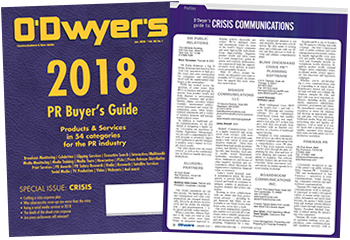|
|
When managing a crisis situation, one of the many strategies a PR practitioner can employ is staging a press conference. For a police department or government agency, it’s a timely and efficient way to get vital information to the public while addressing key questions.
When Hurricane Irma was bearing down on Florida last fall, local emergency management officials and elected politicians took to the podium on a regular basis to update residents on the storm’s path, to announce newly opened shelters, to provide preparation tips and give out other lifesaving advice. When fires engulfed parts of California, residents came to rely on public safety news briefings to make decisions about whether to evacuate. When a serial killer was terrorizing a historic neighborhood in Tampa, the police and mayor used the media to calm fear in the community and ask for the public’s help in finding the perpetrator.
|
|
Incorporating social media, live streams
Even in today’s social world, a news conference is still as relevant as ever. Facebook and Twitter provide a platform to share news, but often times in a crisis, the information being shared is incomplete, inaccurate or made up. A traditional news conference allows one to face the music, set the record straight, address important questions and show empathy. Hearing the real story under intense pressure and scrutiny can lend lots of credibility to the message one is trying to get across.
Savvy PR pros will find ways to leverage social media to widen the audience they’re trying to reach. Our agency recently organized a press conference for a former star professional athlete who was accused of sexually assaulting a younger female acquaintance after a night of socializing over dinner and drinks. With no charges filed and those accusations made public, the former NFL professional held a news conference with his attorney to profess his innocence in no uncertain terms and to call on prosecutors to make a decision on whether to pursue the case.
The news conference was attended by most major media outlets, many of which carried it live on air but also on their Facebook news feed. In addition, we carried the event live on our own page for national media to view, since they logistically could not attend in person. The news conference allowed our client to get his message out in a controlled fashion, set the record straight, take tough questions and maximize the number of people who heard what he had to say.
When preparation meets risk mitigation
In the above example, both subjects of the news conference had plenty of experience with the media and taking tough questions in front of rolling cameras. Which raises an important point. If you’re considering taking this crisis communication route, it’s important to make sure that whoever you put out front is well trained and confident. The last thing you want is someone who can’t stand up to the scrutiny and comes off as ill prepared or dishonest. If the message isn’t delivered in a clear and concise way with either empathy or compassion, the conference could backfire and add more fuel to a fire you’re trying to extinguish.
With a news conference, you can control when and where you disseminate information, as well as the content of your message. Reporters, who have a wide range of angles and agendas, can come at you any number of ways to try and trip you up. But if you’re not prepared or skilled enough to handle the intensity of questions that come your way in a calm, assuring manner, then you should reconsider using this as a forum to communicate, especially considering your words could be heard instantaneously around the world via social media.
But will they come?
One of the most important questions PR professionals ask themselves when contemplating a news conference, is ‘Will anyone show up?’ And is it worth the time and effort? It depends. If you produce a compelling event with elements the reporters need to tell a good story, you stand a good chance. The better you can sell the storyline, the better the chance media will show up. But even then, you might find short-staffed news agencies unable to attend, or you’re pre-empted by breaking news. The way to overcome that is by offering to stream the news conference live on your own social media and web channels and invite reporters and editors to use the material. This is an option we wouldn’t have had a decade ago.
News conference checklist
If you decide a news conference is the way to go when addressing a crisis, the following is a good checklist to use:
Location: Find a location that’s easily accessible for the media, especially TV stations that might want to go live. In years past, broadcast engineers would need to string cables from the TV cameras to a remote antenna or satellite dish, but today, more crews are simply sending back the signal wireless through the Internet. You’ll also want a location that can provide an easy entrance and exit for your speakers to avoid being ambushed outside of the official event. Usually, it’s best to hold a news conference in a controlled environment where there’s also protection from weather elements and easy access to power.
Time: The more advance notice you can give the press, the better. That way they can prepare for the event and staff it properly. A day’s notice is good, but even a few hours’ notice is ok too if for some reason that’s all you can provide. If you believe there will be considerable interest in your news conference, consider holding it during regularly scheduled newscasts, which might take it live and maximize exposure.
Content: You should create a written statement or clear talking points that can be read up front to articulate your message loud and clear. Speakers should also spend significant time doing mock Q-and-As prior to the conference to prepare for all possible questions that might follow. Invite others to attend and speak if they can help corroborate what you have to say. Use visuals if they help tell your story.
Control the environment: With a news conference, you can control a lot, including where it’s held, the start time, what you say and how long you want to talk. As previously mentioned, it’s advisable to take questions, but after a while, reporters might start fishing and asking about things off topic. You’re not obligated to indulge them. When you feel like you’ve finished answering the most important topics, it’s ok to stop and end the proceedings.
The use of a traditional news conference is still as relevant today as it ever was in the right circumstances. Social media can help fuel fire to a crisis but it can also be helpful in casting a wider net and getting your message out to more people than you ever could.
***
Todd Templin and Don Silver lead the crisis management team at BoardroomPR, a Florida-based, full-service communications and integrated marketing firm.

 Todd Templin (L) and Don Silver
Todd Templin (L) and Don Silver 

 There’s a fine line between newsjacking and taking advantage, aka ambulance chasing. Our job as PR professionals is to tread it carefully.
There’s a fine line between newsjacking and taking advantage, aka ambulance chasing. Our job as PR professionals is to tread it carefully. PR firms need to be mindful of ways their work product may be protected by the attorney-client privilege whenever working with a client’s internal legal team or its external legal counsel.
PR firms need to be mindful of ways their work product may be protected by the attorney-client privilege whenever working with a client’s internal legal team or its external legal counsel. Manuel Rocha, former US ambassador and intenational business advisor to LLYC, plans to plead guilty to charges that he was a secret agent for Cuba.
Manuel Rocha, former US ambassador and intenational business advisor to LLYC, plans to plead guilty to charges that he was a secret agent for Cuba. CEO mentoring is an often-overlooked aspect of why CEOs are able to make good decisions, and sometimes make bad ones—all of which intersects with the role and duties of a board.
CEO mentoring is an often-overlooked aspect of why CEOs are able to make good decisions, and sometimes make bad ones—all of which intersects with the role and duties of a board.  How organizations can anticipate, prepare and respond to crises in an increasingly complex world where a convergent landscape of global challenges, threats and risks seem to arrive at an unrelenting pace.
How organizations can anticipate, prepare and respond to crises in an increasingly complex world where a convergent landscape of global challenges, threats and risks seem to arrive at an unrelenting pace.


 Have a comment? Send it to
Have a comment? Send it to 
No comments have been submitted for this story yet.